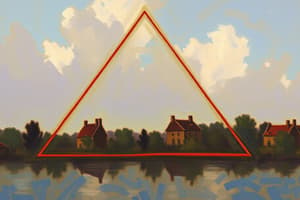Podcast
Questions and Answers
Two shapes are congruent if they are the same shape but different sizes.
Two shapes are congruent if they are the same shape but different sizes.
False (B)
What are the four ways to prove that two triangles are congruent?
What are the four ways to prove that two triangles are congruent?
- SAS (Side, Angle, Side) (correct)
- SSS (Side, Side, Side) (correct)
- ASS (Angle, Side, Side)
- RHS (Right angle, Hypotenuse, Side) (correct)
- ASA (Angle, Side, Angle) or AAS (correct)
What does it mean for two shapes to be similar?
What does it mean for two shapes to be similar?
Two shapes are similar if they are the same shape but different sizes, and the ratios of corresponding sides are equal.
How do you find the scale factor of two similar shapes?
How do you find the scale factor of two similar shapes?
If you know the scale factor between two similar shapes, how can you find a missing length on the larger shape?
If you know the scale factor between two similar shapes, how can you find a missing length on the larger shape?
What are the three conditions that prove two triangles are similar?
What are the three conditions that prove two triangles are similar?
Flashcards
Congruent Shapes
Congruent Shapes
Shapes that are identical in shape and size.
Rotation and Reflection
Rotation and Reflection
Congruent shapes can be rotated or reflected and still be congruent.
Congruent Triangles
Congruent Triangles
Triangles that are identical in shape and size, proven by specific criteria.
SSS
SSS
Signup and view all the flashcards
RHS
RHS
Signup and view all the flashcards
SAS
SAS
Signup and view all the flashcards
ASA
ASA
Signup and view all the flashcards
AAS
AAS
Signup and view all the flashcards
Non-congruent criteria
Non-congruent criteria
Signup and view all the flashcards
Similar Shapes
Similar Shapes
Signup and view all the flashcards
Proportions in Similarity
Proportions in Similarity
Signup and view all the flashcards
Scale Factor
Scale Factor
Signup and view all the flashcards
Calculating Scale Factor
Calculating Scale Factor
Signup and view all the flashcards
Finding Missing Lengths
Finding Missing Lengths
Signup and view all the flashcards
Larger Shape Missing Length
Larger Shape Missing Length
Signup and view all the flashcards
Smaller Shape Missing Length
Smaller Shape Missing Length
Signup and view all the flashcards
Showing Similarity in Triangles
Showing Similarity in Triangles
Signup and view all the flashcards
Three-sided Proportion
Three-sided Proportion
Signup and view all the flashcards
Two-sided Proportion
Two-sided Proportion
Signup and view all the flashcards
Equal Angles
Equal Angles
Signup and view all the flashcards
Triangle Congruence Importance
Triangle Congruence Importance
Signup and view all the flashcards
Similarity Applications
Similarity Applications
Signup and view all the flashcards
Visualizing Congruence
Visualizing Congruence
Signup and view all the flashcards
Visualizing Similarity
Visualizing Similarity
Signup and view all the flashcards
Identifying Congruent Criteria
Identifying Congruent Criteria
Signup and view all the flashcards
Identifying Similarity Criteria
Identifying Similarity Criteria
Signup and view all the flashcards
Triangles as Basics
Triangles as Basics
Signup and view all the flashcards
Proving Relationships
Proving Relationships
Signup and view all the flashcards
Study Notes
Congruence and Similarity
-
Congruent Shapes: Identical shapes, same size and shape. Shapes can be rotated or reflected.
-
Congruent Triangles: Four ways to prove congruence: SSS (Side-Side-Side), RHS (Right angle, Hypotenuse, Side), SAS (Side-Angle-Side), ASA (Angle-Side-Angle) or AAS (Angle-Angle-Side). ASS does not prove congruence.
-
Similar Shapes: Same shape, but different sizes. Corresponding sides are proportional, meaning their ratios are equal.
-
Scale Factor: Ratio of corresponding sides of similar shapes. Calculated by dividing a length on one shape by its corresponding length on the similar shape.
-
Finding Missing Lengths in Similar Shapes:
-
Find the scale factor.
-
Multiply or divide corresponding sides to find missing lengths. Multiplying is used to find missing lengths on the larger shape. Dividing is used to find a missing length on the smaller shape.
-
Similar Triangles: Three ways to show triangles are similar:
-
All three sides are in the same proportion.
-
Two sides are in the same proportion and their included angle is equal.
-
All three angles are equal.
Studying That Suits You
Use AI to generate personalized quizzes and flashcards to suit your learning preferences.




